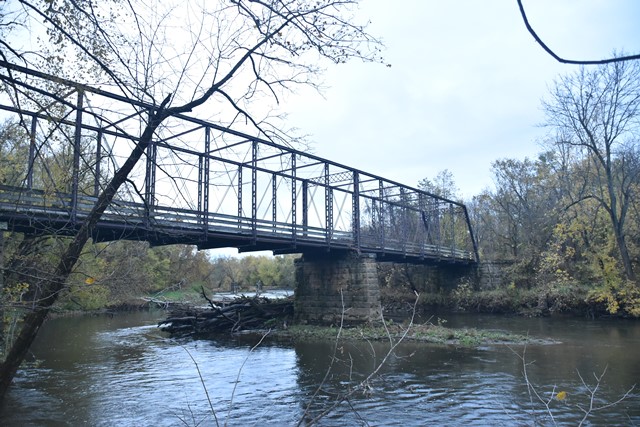We Recommend:
Bach Steel - Experts at historic truss bridge restoration.
Old Zoar Bridge

Primary Photographer(s): Nathan Holth and Rick McOmber
Bridge Documented: August 1, 2007 and October 30, 2016
Near Dover: Tuscarawas County, Ohio: United States
1883 By Builder/Contractor: Wrought Iron Bridge Company of Canton, Ohio
2004
Not Available
Not Available
Not Available
3 Main Span(s)
79XXXX1

View Information About HSR Ratings
Bridge Documentation
This bridge is one of the most unusual bridges in Ohio, and it has a very high level of historic significance due to its rare design. The bridge is in overall design a traditional pin-connected Pratt through truss, and with an 1883 construction date, is significant as an early example. However, it is a three span continuous bridge, making it an extremely early and highly unusual example of a continuous truss bridge. It is also rare as an example of a pin-connected Pratt truss bridge that is continuous. The pin-connected Pratt truss bridges which became a traditional standard and were built across the country during the last two decades of the 1800s were nearly always built as simple spans. The Old Zoar Bridge is a noteworthy deviation from this. It is unclear why the Wrought Iron Bridge Company built this bridge as a continuous structure.
Fortunately, the future of this historic bridge appears secure. The bridge has been preserved and is now in use as a non-motorized crossing.
The bridge has lattice sway bracing where each span meets, and on these sections, if you look closely, you can see that some of the lattice is made of angles, and where they were, they were bent and flattened at the ends to fit in between back-to-back angles. This is an interesting detail to note.
Overall, the preservation of this bridge appears to have been executed in an acceptable manner. However, there is one issue to note in the hope that future bridge preservation projects will not repeat a serious error. Original railings do not remain on the bridge. The most problematic issue with the quality of the preservation of this bridge is the current railings which are thick wooden boards. This type of railing has been a serious problem because so many truss bridges use this in a preservation project. This should be considered an unacceptable installation because there are numerous alternatives that provide a reasonable amount of safety while also not obstructing the view of the historic superstructure.
Information and Findings From Ohio's Historic Bridge InventorySetting/Context Access bridge from Eberhart Rd NW. Physical Description The 3 span, pin-connected Pratt thru truss bridge has built-up compression members and eyebar or rod tension members. It has the cast connecting pieces at the upper chord-end posts connections through which to thread the diagonals, so typical of Wrought Iron Bridge Co. bridges of this period. There are lattice portal bracing with lattice brackets and builders plaques. The available photo appears to show the truss to be continuous over the piers, a very unusual practice for 1883. Summary of Significance The 1883 pin-connected Pratt thru truss bridge on old CR 82 was bypassed prior to 1976. Although there was some threat of removing the bridge in the mid 1980s, it was eventually rehabilitated for use as part of
the Zoar Valley Trail in 2004. It is a very technologically significant example of its type/design with details associated with the Wrought Iron Bridge Co., a prominent Ohio fabricator. The eligible recommendation of the prior
inventory remains appropriate. Justification The bridge is one of over 150 extant pin-connected truss bridges dating from 1874 for pony trusses and 1876 for thru trusses. Twenty six predate 1888 and represent the era of experimentation that evolved into standardized designs by about 1888. This example has moderate significance because the genre and the fabricator are so well represented in Ohio. Bridge Considered Historic By Survey: Yes |
This bridge is tagged with the following special condition(s): Reused and Unorganized Photos
![]()
Photo Galleries and Videos: Old Zoar Bridge
Bridge Photo-Documentation
A collection of overview and detail photos. This photo gallery contains a combination of Original Size photos and Mobile Optimized photos in a touch-friendly popup viewer.Alternatively, Browse Without Using Viewer
![]()
2016 Additional Unorganized Photos
Original / Full Size PhotosA supplemental collection of photos that are from additional visit(s) to the bridge and have not been organized or captioned. This gallery offers photos in the highest available resolution and file size in a touch-friendly popup viewer.
Alternatively, Browse Without Using Viewer
![]()
2016 Additional Unorganized Photos
Mobile Optimized PhotosA supplemental collection of photos that are from additional visit(s) to the bridge and have not been organized or captioned. This gallery features data-friendly, fast-loading photos in a touch-friendly popup viewer.
Alternatively, Browse Without Using Viewer
![]()
Maps and Links: Old Zoar Bridge
Coordinates (Latitude, Longitude):
Search For Additional Bridge Listings:
Bridgehunter.com: View listed bridges within 0.5 miles (0.8 kilometers) of this bridge.
Bridgehunter.com: View listed bridges within 10 miles (16 kilometers) of this bridge.
Additional Maps:
Google Streetview (If Available)
GeoHack (Additional Links and Coordinates)
Apple Maps (Via DuckDuckGo Search)
Apple Maps (Apple devices only)
Android: Open Location In Your Map or GPS App
Flickr Gallery (Find Nearby Photos)
Wikimedia Commons (Find Nearby Photos)
Directions Via Sygic For Android
Directions Via Sygic For iOS and Android Dolphin Browser
USGS National Map (United States Only)
Historical USGS Topo Maps (United States Only)
Historic Aerials (United States Only)
CalTopo Maps (United States Only)


